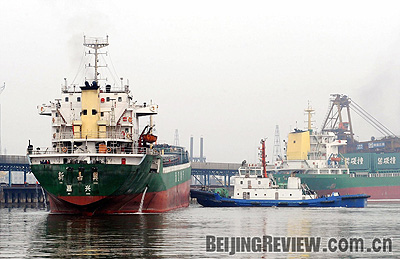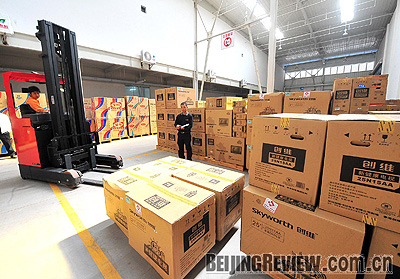| With its infrastructure boom roaring on, China has prided itself on a sprawling and ever-faster logistics and transportation network that stretches across the country. But is the network strong enough to resist disruptions? Probably not.
 |
|
POWER LIFT: China is undertaking a series of measures to spur its logistics industry with its weighty importance to the national economy(CHEN HAINING) |
 |
|
COLLISION COURSE: China's logistics sector faces slower growth because of the economic downturn and fragmented industry structure (By YANG SHIYAO) | Problems during last year's snowstorm show why. Under the heavy weight of snow and sleet, the seemingly strong logistics system ground to a halt. A number of airports and highways in south China were shut down, threatening to block food supplies. Snow drifts hampered the already challenged railway transport of coal needed for power generation, leaving millions in the dark and cold.
But policy-makers have learned a lesson from the transport crunch. The State Council recently devised a revitalization program for the next three years in an effort to make the transport system more efficient, and more importantly, boost the entire logistics industry. It is the first time the government has created such a sweeping package, laying out long-term goals for the industry. And analysts say it could serve as a curtain raiser for future policies in the sector.
The program aims to build a modern logistics system in several ways. First, it would broaden market demand for logistics services, encourage manufacturers to farm out their supply-chain management, and improve the professional services of logistics companies. Second, it would accelerate mergers and acquisitions in the sector to nurture a number of internationally competitive logistics enterprises offering superior services. Third, it would develop logistics services in major sectors such as energy, mining, automobiles, agricultural production and pharmaceuticals. Fourth, it would press ahead with infrastructure construction and enhance standardization in the industry.
In addition, the program also calls on relevant authorities to deepen reforms of the oversight system and strengthen the training of professional talent. Nine key projects also are included in the program, including fostering distribution centers, promoting urban delivery and wholesale and rural logistics, and building information platforms.
Last but not least
Logistics was the last item to be included on the government's industry revitalization agenda, but it certainly was not the least.
As a composite service industry combining transport, storage, freight agencies and express delivery, it is known as the "enabler of commerce." From warehouse management to home delivery, logistics services provide efficient connections between each link of the industrial supply chain. On a global scale, cross-continent shipping has been one of the driving forces of today's dynamic global trade.
|
